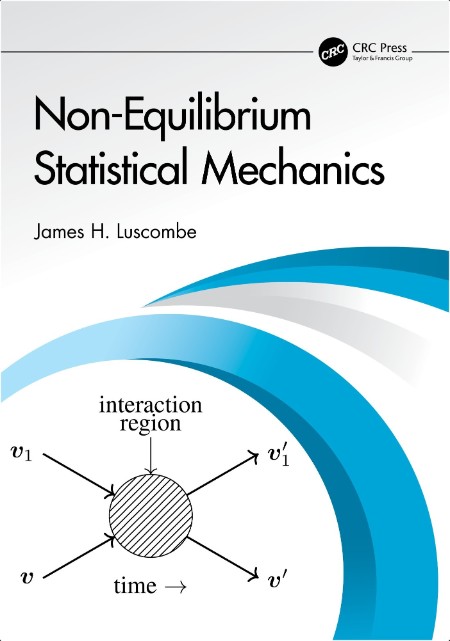- Témaindító
- #1
- Csatlakozás
- 2020.09.06.
- Üzenetek
- 7,198
- Reakció pontszám
- 74
- Díjak
- 5

Luscombe J Non-Equilibrium Statistical Mechanics 2024 | 5.17 MB
257 Pages
Title: Non-Equilibrium Statistical Mechanics
Author: James H. Luscombe
Description:
Statistical mechanics provides a framework for relating the properties of macroscopic systems (large collections of atoms, such as in a solid) to the microscopic properties of its parts. However, what happens when macroscopic systems are not in thermal equilibrium, where time is not only a relevant variable, but also essential?
That is the province of nonequilibrium statistical mechanics - there are many ways for systems to be out of equilibrium! The subject is governed by fewer general principles than equilibrium statistical mechanics and consists of a number of different approaches for describing nonequilibrium systems.
Financial markets are analyzed using methods of nonequilibrium statistical physics, such as the Fokker-Planck equation. Any system of sufficient complexity can be analyzed using the methods of nonequilibrium statistical mechanics. The Boltzmann equation is used frequently in the analysis of systems out of thermal equilibrium, from electron transport in semiconductors to modeling the early Universe following the Big Bang.
This book provides an accessible yet very thorough introduction to nonequilibrium statistical mechanics, building on the author's years of teaching experience. Covering a broad range of advanced, extension topics, it can be used to support advanced courses on statistical mechanics, or as a supplementary text for core courses in this field.
Key Features:
· Features a clear, accessible writing style which enables the author to take a sophisticated approach to the subject, but in a way that is suitable for advanced undergraduate students and above.
· Presents foundations of probability theory and stochastic processes and treats principles and basic methods of kinetic theory and time correlation functions.
· Accompanied by separate volumes on thermodynamics and equilibrium statistical mechanics, which can be used in conjunction with this book
James H. Luscombe received the PhD in Physics from the University of Chicago in 1983. After post-doctoral positions at the University of Toronto and Iowa State University, he joined the Research Laboratory of Texas Instruments, where he worked on the development of nanoelectronic devices. In 1994, he joined the Naval Postgraduate School in Monterey, CA, where he is Professor of Physics. He was Chair of the Department of Physics from 2003 - 2009. He teaches a wide variety of topics, including general relativity, statistical mechanics, mathematical methods, and quantum computation. He has published more than 60 research articles, and has given more than 100 conference presentations; he holds 2 patents.
DOWNLOAD:
Statistical mechanics provides a framework for relating the properties of macroscopic systems (large collections of atoms, such as in a solid) to the microscopic properties of its parts. However, what happens when macroscopic systems are not in thermal equilibrium, where time is not only a relevant variable, but also essential?
That is the province of nonequilibrium statistical mechanics - there are many ways for systems to be out of equilibrium! The subject is governed by fewer general principles than equilibrium statistical mechanics and consists of a number of different approaches for describing nonequilibrium systems.
Financial markets are analyzed using methods of nonequilibrium statistical physics, such as the Fokker-Planck equation. Any system of sufficient complexity can be analyzed using the methods of nonequilibrium statistical mechanics. The Boltzmann equation is used frequently in the analysis of systems out of thermal equilibrium, from electron transport in semiconductors to modeling the early Universe following the Big Bang.
This book provides an accessible yet very thorough introduction to nonequilibrium statistical mechanics, building on the author's years of teaching experience. Covering a broad range of advanced, extension topics, it can be used to support advanced courses on statistical mechanics, or as a supplementary text for core courses in this field.
Key Features:
· Features a clear, accessible writing style which enables the author to take a sophisticated approach to the subject, but in a way that is suitable for advanced undergraduate students and above.
· Presents foundations of probability theory and stochastic processes and treats principles and basic methods of kinetic theory and time correlation functions.
· Accompanied by separate volumes on thermodynamics and equilibrium statistical mechanics, which can be used in conjunction with this book
James H. Luscombe received the PhD in Physics from the University of Chicago in 1983. After post-doctoral positions at the University of Toronto and Iowa State University, he joined the Research Laboratory of Texas Instruments, where he worked on the development of nanoelectronic devices. In 1994, he joined the Naval Postgraduate School in Monterey, CA, where he is Professor of Physics. He was Chair of the Department of Physics from 2003 - 2009. He teaches a wide variety of topics, including general relativity, statistical mechanics, mathematical methods, and quantum computation. He has published more than 60 research articles, and has given more than 100 conference presentations; he holds 2 patents.
DOWNLOAD:
Code:
⚠
A kód megtekintéséhez jelentkezz be.
Please log in to view the code.
Code:
⚠
A kód megtekintéséhez jelentkezz be.
Please log in to view the code.
